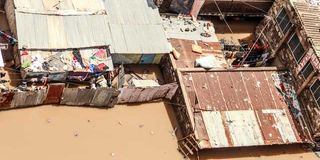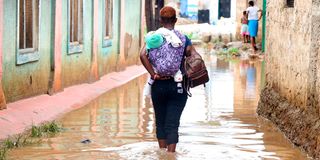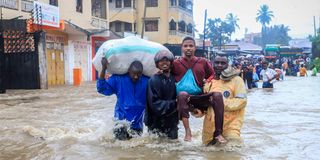Premium
Cyclone Hidaya to hit Kenyan Coast, effects will be dire

Beach operators at the Jomo Kenyatta Public Beach in Mombasa. The Coast region is likely to be hit by Cyclone Hidaya, which will result in heavy rainfall, large waves and strong winds. Kevin Odit.
The Coast region is likely to be hit by Cyclone Hidaya, which will result in heavy rainfall, large waves and strong winds that could affect activities in the Indian Ocean, a report to the Cabinet has warned.
The Cabinet, which met for the second time this week, was also told that average to above-average rains will continue being experienced in across the country for the next three months. It was further informed that flooding is expected in low-lying areas, as are landslides and mudslides
On President William Ruto’s Tuesday directive that people living in riparian lands move out, the Cabinet noted that those affected had received the news positively. President Ruto had ordered that they vacate the areas within 48 hours.
The President and his Cabinet yesterday met to “deliberate on extra measures to mitigate the devastating effects of flooding, mudslides and landslides in many parts of the country”.
Schools, the Cabinet was told, have particularly suffered the vagaries of the extreme weather, with some flooded while others are being occupied by people who have been displaced.

Houses marooned by floodwater at Kware area in Pipeline, Nairobi after heavy rains on May 1, 2024.
“On the adverse effects of weather conditions on schools, Cabinet was informed that infrastructure, including classrooms, dormitories, halls, toilets, latrines fences and perimeter walls, has been destroyed,” read the dispatch from Cabinet. “To repair and rehabilitate destroyed school infrastructure, the Cabinet directed that the Ministry of Education works with the National Government-Constituency Development Fund.”
The Cabinet noted that more citizens who have been affected by floods, mudslides and landslides are receiving help in the form of food and non-food items from the government and partners.
Noting that the flooding, mudslides, landslides and extreme weather conditions are a result of climate change, the Cabinet resolved that the government will rally the country to implement measures, programmes and policies that will mitigate these effects.

A woman with baby wades through a flooded path on her way to the hospital in Bombolulu, Mombasa County following heavy rains on November 16, 2023.
Following the Cabinet deliberations and warnings by the meteorology department, the government has ordered people residing in flood-prone areas across five counties in the Coast region to vacate within 24 hours or be forcefully evacuated.
The areas in Kilifi, Taita-Taveta, Tana River, Kwale and Lamu counties are among a list of others in 33 counties that are close to high-risk dams and water reservoirs.
In its order for people at risk of flooding to vacate, the Ministry of Interior said there is a high risk of floods in Msambweni (Kwale), Ganze and Malindi (Kilifi), Lamu Central (Lamu) and Taita and Taveta (Taita-Taveta) the sub-counties .
The order, which was effective yesterday at 6.30pm, was also issued to residents in areas prone to landslides or mudslides in Nandi, West Pokot, Elgeyo-Marakwet, Murang’a, Nyeri, Machakos and Makueni counties.
The coastal region has so far not experienced the heavy rainfall being witnessed in other parts of the country but the flooding is expected to be caused by water from upstream which is filling up rivers and dams.
Interior Cabinet Secretary Kithure Kindiki ordered county security and intelligence committees to determine the scope of areas to be subjected to the order on a case-by-case basis.

Pedestrians cross a flooded street following heavy rains at Kiembeni in Mombasa.
“The government has put in place adequate measures to provide temporary shelter as well as food and non-food essential supplies to all those that will be affected by these orders in the event that they require assistance,” he noted in a statement to newsrooms.
Prof Kindiki also ordered people living within riparian lands to vacate within 24 hours or be subjected to mandatory evacuation.
This order affects those residing within the 30-metre riparian corridor of rivers and other water courses.
The vacation will be followed by the demolition of structures.
At the same time, the Weatherman has warned of heavier and intense rains today and through the weekend.
Kenya Meteorological Department Director-General David Gikungu told the Nation that despite May usually marking the end of the long rains season, many parts of the country might experience increased rainfall until June.
“We anticipate this weather pattern to continue until late May in certain regions, with the possibility of extending into June, especially along the coastal and western areas of Kenya. It’s crucial for communities affected by these weather conditions to remain continuously prepared and vigilant, as emphasised in these forecasts,” he said.
Dr Gikungu further noted that the persistence of the El Nino phenomenon, observed since the short-range forecast of 2023, has continued to influence weather patterns well into 2024. This influence, he stated, remains strong enough to impact cloud formations and precipitation, resulting in the current heavy rainfall.
“Due to that occurrence, the effects extended into January, briefly paused, yet the signal remained robust. Consequently, as we formulated the long-range forecast for 2024, particularly notable for the United States in March and last year’s May, it became evident that this phenomenon would persistently impact the current season,” he said, highlighting the need for communities to remain vigilant and prepared for continued inclement weather.
“Those settlers within the riparian land have been, it didn’t even sound like advice, they were ordered to move. Anywhere 30 metres on either side of the river, they are supposed to move away because there shouldn’t be any settlement there,” Dr Gikungu said.

Trucks on the highway.
Dr Gikungu also emphasised the importance of proactive measures such as monitoring flood-prone areas and clearing debris to mitigate the impact of flooding.
“It is possible to also make sure that we monitor areas that are prone or they provide waterways. It is possible for us to just monitor that and keep on clearing any debris that may accumulate and cause blockage of water, and then the same water finds itself in the residential areas ... it is possible for us to take care of that,” he noted.
Dr Gikungu reassured the public that efforts to enhance weather warning systems are underway, through collaborations with meteorological authorities and organisations
Reports by Daniel Ogetta, Valentine Obara and Mercy Simiyu





